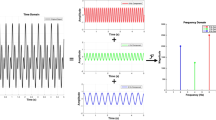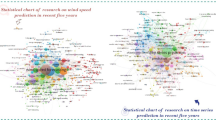Abstract
Wind energy is one of the fastest-growing renewable energy resources. The blades are regarded as one of the most critical components in a wind turbine. The appropriate detection scheme to ensure the safety of the blade is crucial. Although there are many ways to detect blade damage and distinguish the types of them, a real-time online blade alert is important to ensure that potential wind turbine problems can be corrected in a timely manner. In this paper, a wind turbine blade damage early warning system was designed and developed based on sound signal fusion. Firstly, a wind turbine blade early warning method based on wavelet packet decomposition is proposed, which mainly includes data processing, feature extraction and early warning mechanism. Specifically, the beamforming technology of minimum variance distortion-less response(MVDR) is applied to enhance the weak signal and suppress the interference signal in the data processing. In the feature extraction, four-layer wavelet packet decomposition is applied to fully retain the information in the original signal. To improve the robustness of early warning, the two early warning strategies are introduced into in early warning mechanism. Then, a wind turbine blade damage early warning system was developed based on specific hardware. Finally, the system is tested on active wind farms and can achieve good early warning results.









Similar content being viewed by others
References
Kazmerski, L.: Renewable and sustainable energy reviews. Renew. Sustain. Energy Rev. 38, 834–847 (2016). https://doi.org/10.1016/j.rser.2014.07.023
Yang, W., Crabtree, C.J.: Cost-effective condition monitoring for wind turbines. IEEE Trans. Ind. Electron. 57, 263–271 (2010). https://doi.org/10.1088/0964-1726/24/3/033001
Keatley, P., Shibli, A., Hewitt, N.J.: Estimating power plant start cost sincyclic operation. Appl. Energy 111, 550–557 (2013). https://doi.org/10.1016/j.apenergy.2013.05.033
Guo, W.L.: Causes and countermeasures of large wind turbine blade damage. Electr. Power Saf. Technol. 16(005), 10–13 (2014). https://doi.org/10.1049/cp.2013.2109
Marsh, G.: Meeting the challenge of wind turbine blade repair. Reinf. Plast. 55, 32–36 (2011). https://doi.org/10.1016/s0034-3617(11)70112-6
D.Y. Kim, H.B. Kim, W.S. Jung, S. Lim, J. Hwang, Visual testing system for the damaged area detection of wind power plant blade, in Proceedings of the 2013 44th International symposium on robotics (ISR), pp. 1–5. (2013). https://doi.org/10.1109/ISR.2013.6695675
Liu, Q.X., Wang, Z.H., Long, S.G., Cai, M., Wang, X.: Research on automatic positioning system of ultrasonic testing of wind turbine blade flaws. IOP Conf. 93, 012074 (2017). https://doi.org/10.1088/1755-1315/93/1/012074
Tiwari, K.A., Raisutis, R.: Refinement of defect detection in the contact and non-contact ultrasonic non-destructive testing of wind turbine blade using guided waves. Procedia Struct.l Integr. 13, 1566–1570 (2018). https://doi.org/10.1016/j.prostr.2018.12.320
Shi, Y.: Phased array ultrasonic testing of glass fiber composite materials on wind turbine blades. Nondestruct. Test. (2018). https://doi.org/10.11973/wsjc201811014
Neuensch, J., Furrer, R., Roemmeler, A.: Application of air-coupled ultrasonics for the characterization of polymer and polymer-matrix composite samples. Polym. Test. 56, 379–386 (2016). https://doi.org/10.1016/j.polymertesting.2016.11.002
Park, B., An, Y.K., Sohn, H.: Visualization of hidden delamination and debonding in composites through noncontact laser ultrasonic scanning. Compos. Sci. Technol. 100, 10 (2014). https://doi.org/10.1016/j.compscitech.2014.05.029
P. Tao, Y.Z. Zhao, K.Y. Zhou, E.T. Yao, Y. Shi, P. Xu, A research of wind turbine blade delamination detection technology based on the acoustic impact, in Proceedings of the 11th European conference on non-destructive testing: Prague, Czech Republic. (2014). https://www.ndt.net/events/ECNDT2014/app/content/Paper/640_Zhou_Rev1
Rizk, P., Younes, R., Ilinca, A., Khoder, J.: Defect detection using hyperspectral imaging technology on wind turbine blade. Rem. Sens. Appl. Soc. Env. 22(3), 100522 (2021). https://doi.org/10.1016/j.rsase.2021.100522
Regan, T., Beale, C.: Wind turbine blade damage detection using supervised machine learning algorithms. J. Vibr. Acoust. (2017). https://doi.org/10.1115/1.4036951
Rizk, P., Saleh, N.A., Younes, R., Ilinca, A., Khoder, J.: Hyperspectral imaging applied for the detection of wind turbine blade damage and icing. Rem. Sens. Appl. Soc. Env. 18, 100291 (2020). https://doi.org/10.1016/j.rsase.2020.100291
Yousuf, A., Jia, Y.J., Sokolov, P., Virk, M.S.: Study of ice accretion on wind turbine blade profiles using thermal infrared imaging. Wind Eng. (2020). https://doi.org/10.1177/0309524X20933948
Zhou, B., Zhang, X., Li, H.: Study on air bubble defect evolution in wind turbine blade by infrared imaging with rheological theory. Appl. Sci. 9(22), 4742 (2019). https://doi.org/10.3390/app9224742
Heuer, H., Schulze, M., Pooch, M., Gäbler, S., Nocke, A.: Review on quality assurance along the CFRP value chai non-destructive testing of fabrics, preforms and CFRP by HF radio wave techniques. Compos. B-Eng. 77, 494–501 (2015). https://doi.org/10.1016/j.compositesb.2015.03.022
M.H. Schulze, H. Heuer, Textural analyses of carbon fiber materials by 2D-FFT of complex images obtained by high frequency eddy current imaging (HF-ECI), in Non-destructive characterization for composite materials, aerospace engineering, civil infrastructure, and home land security, p. 83470S. (2012). https://doi.org/10.1117/12.914832
Dx, A., Pfl, B., Zpc, A.: Damage mode identification and singular signal detection of composite wind turbine blade using acoustic emission—science direct. Compos. Struct. (2020). https://doi.org/10.1016/j.compstruct.2020.112954
Chen, B., Yu, S., Yu, Y., Zhou, Y.: Acoustical damage detection of wind turbine blade using the improved incremental support vector data description. Renew. Energy (2020). https://doi.org/10.1016/j.renene.2020.04.096
Muñoz, G., Quiterio, C., Márquez, G., Pedro, F.: A new fault location approach for acoustic emission techniques in wind turbines. Energies 9, 40 (2016). https://doi.org/10.3390/en9010040
Li, Y., Sheng, X., Lian, M.: Influence of tilt angle on eddy current displacement measurement. Nondestruct. Test. Eval. 31(4), 289–302 (2016). https://doi.org/10.1080/10589759.2015.1081905
X. Sheng, Y. Li, M. Lian, Influence of coupling interference on arrayed eddy current displacement measurement. Mater. Eval. 74(12): 1675–1683 (2016). https://ndtlibrary.asnt.org/2016/InfluenceofCouplingInterferenceonArrayedEddyCurrentDisplacementMeasurement
Chao, X., Li, Y., Nie, J.: Tilt angle measurement based on arrayed eddy current sensors. J. Magn. 21(4), 524–528 (2016). https://doi.org/10.4283/JMAG.2016.21.4.524
Nie, J., Li, Y., She, S.: Magnetic shielding analysis for arrayed eddy current testing. J. Magn. 24(2), 328–332 (2019). https://doi.org/10.4283/JMAG.2019.24.2.328
Calabrese, L., Campanella, G., Proverbio, E.: Noise removal by cluster analysis after long time ae corrosion monitoring of steel reinforcement in concrete. Constr. Build. Mater. 34, 362–371 (2012). https://doi.org/10.1016/j.conbuildmat.2012.02.046
Mejia, F., Mei-Ling, S., Antonio, N.: Data quality enhancement and knowledge discovery from relevant signals in acoustic emission. Mech. Syst. Signal Process. (2015). https://doi.org/10.1016/j.ymssp.2015.02.017
Kharrat, M., Ramasso, E., Placet, V., et al.: A signal processing approach for enhanced acoustic emission data analysis in high activity systems: application to organic matrix composites. Mech. Syst. Signal Process. 70–71, 1038–1055 (2016). https://doi.org/10.1016/j.ymssp.2015.08.028
Li, L.: Feature extraction of ae characteristics in offshore structure model using hilbert–huang transform. Measurement (2011). https://doi.org/10.1016/j.measurement.2010.09.002
Chai, M., Zhang, Z., Duan, Q.: A new qualitative acoustic emission parameter based on shannon’s entropy for damage monitoring. Mech. Syst. Signal Process. 100, 617–629 (2018). https://doi.org/10.1016/j.ymssp.2017.08.007
Safaa, K.H., Jumaili, A.L., Mark, J., et al.: Characterisation of fatigue damage in composites using an acoustic emission parameter correction technique. Compos. B Eng. (2018). https://doi.org/10.1016/j.compositesb.2018.06.020
Saeedifar, M., Fotouhi, M., Najafabadi, M.A., Toudeshky, H.H., Minak, G.: Prediction of quasi-static delamination onset and growth in laminated composites by acoustic emission. Compos. B Eng. (2016). https://doi.org/10.1016/j.compositesb.2015.09.037
Li, Y., Yang, J.: Meta-learning baselines and database for few-shot classification in agriculture. Comput. Electron. Agric. 182(5), 106055 (2021). https://doi.org/10.1016/j.compag.2021.106055
Li, Y., Chao, X.: Semi-supervised few-shot learning approach for plant diseases recognition. Plant Methods 17, 1 (2021). https://doi.org/10.1186/s13007-021-00770-1
Li, Y., Yang, J.: Few-shot cotton pest recognition and terminal realization. Comput. Electron. Agr. 169, 105240 (2020). https://doi.org/10.1016/j.compag.2020.105240
Chao, X., Zhang, L.: Few-shot imbalanced classification based on data augmentation. Multimedia Syst. 2021, 1–9 (2021). https://doi.org/10.1007/s00530-021-00827-0
Yang, Y., Zhang, Z., Mao, W., Li, Y., Lv, C.: Radar target recognition based on few-shot learning. Multimedia Syst. 2021, 1–11 (2021). https://doi.org/10.1007/s00530-021-00832-3
Ming, P., Lu, J., Hu, S., Fan, X., Lin, J.: Determination of the optimal decomposition layer of wavelet de-noising based on signal band feature. Russ. J. Nondestr. Test. 55(1), 39–47 (2019). https://doi.org/10.1134/S1061830919010066
Author information
Authors and Affiliations
Corresponding author
Additional information
Publisher's Note
Springer Nature remains neutral with regard to jurisdictional claims in published maps and institutional affiliations.
Rights and permissions
Springer Nature or its licensor (e.g. a society or other partner) holds exclusive rights to this article under a publishing agreement with the author(s) or other rightsholder(s); author self-archiving of the accepted manuscript version of this article is solely governed by the terms of such publishing agreement and applicable law.
About this article
Cite this article
Li, X. Few-shot wind turbine blade damage early warning system based on sound signal fusion. Multimedia Systems 29, 2913–2922 (2023). https://doi.org/10.1007/s00530-021-00882-7
Received:
Accepted:
Published:
Issue Date:
DOI: https://doi.org/10.1007/s00530-021-00882-7




